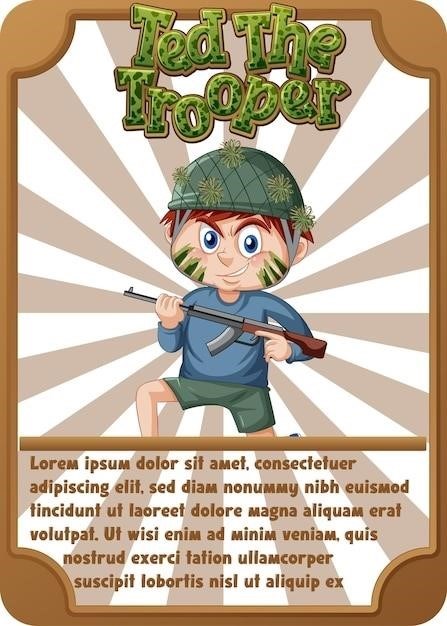The West Between the Wars⁚ A Guided Reading Activity
This guided reading activity will explore the tumultuous period between World War I and World War II, a time of profound change and upheaval in the Western world․ It will delve into the challenges of maintaining peace after the Great War, the devastating impact of the Great Depression, and the rise of authoritarian regimes that reshaped the political landscape․
Introduction
The period between World War I and World War II, often referred to as the “interwar years,” was a time of immense change and turmoil in the Western world․ This period witnessed the rise of new ideologies, the collapse of empires, and the emergence of new political and economic powers․ The events of this era had a profound impact on global politics, economics, and social structures, laying the groundwork for the future of the 20th century․
This guided reading activity will explore the key themes and events that shaped the West between the wars․ We will examine the challenges of maintaining peace after the devastation of World War I, the economic crisis of the Great Depression, and the rise of authoritarian regimes, including fascism and Nazism․ We will also investigate the impact of these events on the social, cultural, and intellectual landscape of the West, and explore the lasting legacies of this turbulent period․
By engaging with these topics, you will gain a deeper understanding of the complex and dynamic forces that shaped the world in the years between the two world wars․ This knowledge will provide a valuable foundation for understanding the events that led to World War II, as well as the challenges and opportunities faced by the West in the decades that followed․
Instability After World War I
The end of World War I brought a wave of optimism for a new era of peace and international cooperation․ However, the fragile peace was quickly shattered by a series of challenges that threatened to unravel the hard-won victory․ The Treaty of Versailles, imposed upon Germany, was seen as harsh and punitive, sowing the seeds of resentment and future conflict․ The treaty demanded crippling reparations from Germany, fueling economic instability and political unrest․
Furthermore, the war’s aftermath saw the redrawing of national borders and the collapse of empires, leading to the creation of new nation-states often with unresolved territorial disputes and ethnic tensions․ The League of Nations, established to promote international cooperation and prevent future wars, struggled to gain legitimacy and effectiveness․ The United States, wary of entangling alliances, refused to join the League, further weakening its authority․
The political landscape of Europe was also marked by instability․ The rise of extremist ideologies, both on the left and the right, challenged the existing order․ The Bolshevik Revolution in Russia and the spread of communist ideas across Europe raised fears of radical change and social upheaval․ Meanwhile, the rise of nationalism and fascist movements in Italy and Germany offered a stark alternative to democratic governance․
The Economic Crisis of the Great Depression
The 1920s, despite the lingering effects of the war, witnessed a period of economic prosperity and growth in many Western nations․ However, this period of boom was ultimately built on shaky foundations․ The overproduction of goods, coupled with excessive speculation in the stock market, created a bubble that was destined to burst․ In 1929, the stock market crash in the United States triggered a global economic crisis, known as the Great Depression, that plunged the world into a decade of widespread unemployment, poverty, and social unrest․
The Great Depression had a profound impact on Europe․ The war-torn economies of European nations were already fragile, and the economic crisis exacerbated existing problems․ Trade declined drastically, leading to a sharp drop in industrial production and a rise in unemployment․ The collapse of the international financial system made it difficult for countries to access credit and invest in recovery efforts․ The Depression also led to political instability, as governments struggled to cope with the economic crisis and social unrest․

The Great Depression had a profound impact on the lives of ordinary people․ Millions lost their jobs, homes, and savings․ People were forced to rely on charity and government assistance to survive․ The Depression also led to a rise in social unrest and political extremism, as people sought solutions to their economic woes․
The Rise of Dictatorial Regimes
The economic and social turmoil of the Great Depression created a fertile ground for the rise of authoritarian regimes in Europe․ In a world shaken by instability and uncertainty, people sought strong leaders who promised order, stability, and a return to national greatness․ These leaders often capitalized on popular anxieties and frustrations, exploiting fears of communism, economic hardship, and national humiliation to consolidate their power․
In Italy, Benito Mussolini rose to power in 1922, promising to restore national pride and economic stability․ He established a fascist regime that suppressed opposition, controlled the media, and promoted a cult of personality․ Mussolini’s regime, while initially popular, ultimately led to the suppression of civil liberties and the persecution of political opponents․
In Germany, the economic devastation of the Great Depression coupled with the humiliation of defeat in World War I created a climate of instability and resentment․ The Nazi Party, led by Adolf Hitler, exploited these anxieties and promised to restore German greatness and create a new order based on racial purity and national expansion․ Hitler’s rise to power in 1933 marked a turning point in European history, ushering in a period of totalitarian rule and aggression that would culminate in World War II․
The Fascist State
The rise of fascism in the interwar period represented a significant departure from traditional forms of political organization․ Fascism emerged as a reaction to the perceived failures of liberal democracy and the perceived threats of communism and socialism․ It promoted a strong, centralized state, a cult of the leader, and a rejection of individual rights in favor of national unity and purpose․
Fascist ideology emphasized the importance of national unity, racial purity, and a hierarchical social structure․ It rejected the principles of individual liberty and equality, instead promoting a sense of collective identity and obedience to the state․ Fascist regimes often relied on propaganda, censorship, and the suppression of dissent to maintain control․

The fascist state aimed to create a society in which all aspects of life, from education to the economy, were controlled and directed by the government; It sought to mobilize the population for national goals, whether through military conquest or economic development, and to create a sense of shared purpose and destiny․ While fascism originated in Italy with Benito Mussolini, it spread to other countries in Europe and beyond, influencing the rise of Nazi Germany and other authoritarian regimes․
Hitler and Nazi Germany
Adolf Hitler, a charismatic and ruthless leader, emerged in Germany in the aftermath of World War I and the Great Depression․ Capitalizing on widespread economic hardship, social unrest, and resentment over the Treaty of Versailles, Hitler’s Nazi Party gained immense popularity․ Hitler’s ideology, a toxic blend of extreme nationalism, anti-Semitism, and racial supremacy, resonated with a population desperate for order and stability․
The Nazi Party’s rise to power was marked by a series of political maneuvers, including the exploitation of the Weimar Republic’s weaknesses and the use of violence and intimidation against political opponents․ After gaining control of the Reichstag, Hitler consolidated his power through a series of laws that effectively eliminated opposition and established a totalitarian dictatorship․
Hitler’s Nazi regime unleashed a reign of terror, persecuting minorities, particularly Jews, and suppressing any dissent․ His ambition for a Greater German Reich led to the annexation of Austria and Czechoslovakia, culminating in the invasion of Poland in 1939, marking the beginning of World War II․ Hitler’s reign of terror and aggression left an indelible mark on history, forever associating the Nazi regime with genocide, war, and the destruction of human values․
The West Between the Wars⁚ Conclusion
The period between the two World Wars was a tumultuous era for the West, marked by economic instability, political upheaval, and the rise of ideologies that challenged the established order․ The aftermath of World War I left deep scars on European society, fostering disillusionment with the traditional values of democracy and liberalism․ The economic devastation of the Great Depression further exacerbated these anxieties, creating fertile ground for the rise of authoritarian movements․
The rise of fascist and totalitarian regimes in Italy, Germany, and other countries demonstrated the fragility of democratic institutions and the allure of strong leadership during times of crisis․ The West grappled with the consequences of these political shifts, witnessing the erosion of individual freedoms and the suppression of dissent․ The global stage was set for a new era of conflict, as the aggressive expansionism of Nazi Germany and the militaristic ambitions of Japan shattered the fragile peace that had followed World War I․
The West Between the Wars serves as a cautionary tale, reminding us of the importance of economic stability, social justice, and the preservation of democratic values in a world increasingly shaped by global interconnectedness and the challenges of navigating a complex and often unpredictable geopolitical landscape․
Additional Resources
To deepen your understanding of the West Between the Wars, consider exploring these additional resources⁚
- Primary Sources⁚ Delve into firsthand accounts of the era through diaries, letters, speeches, and newspaper articles․ The Library of Congress and the National Archives offer vast digital collections of primary source materials․
- Documentaries and Films⁚ Films such as “The Great War” (1964) and “The Sorrow and the Pity” (1969) provide powerful visual narratives of the period․ Documentaries on the rise of fascism and the Great Depression offer insightful perspectives․
- Academic Journals⁚ Explore scholarly articles on the West Between the Wars published in journals such as “The American Historical Review,” “The Journal of Modern History,” and “The Journal of European History․” These articles offer in-depth analyses of various aspects of the period․
- Online Resources⁚ Websites like the International Committee of the Red Cross, the United Nations, and the World Bank offer valuable information on the international response to the challenges of the interwar years․
- Museums and Historical Sites⁚ Visit museums and historical sites dedicated to World War I, the Great Depression, or the rise of fascism․ These locations provide tangible connections to the events and experiences of the era․
By exploring these additional resources, you can gain a more comprehensive understanding of the complex and multifaceted period that shaped the world we live in today․
Reflection
After completing this guided reading activity, take a moment to reflect on the key takeaways and consider the following questions⁚
- What were the most significant challenges facing the West in the interwar period? How did these challenges contribute to the instability and turmoil of the era?
- How did the economic crisis of the Great Depression impact the political landscape of the West? What were the consequences of the economic collapse on the rise of authoritarian regimes?
- What were the key features of the fascist state? How did fascist ideology and practices differ from traditional forms of government?
- How did the actions of Hitler and Nazi Germany in the interwar period set the stage for World War II? What were the consequences of their policies on the future of Europe and the world?
- What lessons can be learned from the West Between the Wars about the dangers of economic instability, political extremism, and international conflict? How can we use these lessons to prevent similar crises in the future?
This guided reading activity serves as a starting point for exploring the tumultuous period between the world wars․ Further research and reflection will allow you to delve deeper into the complexities of this era and develop a greater understanding of its lasting impact on the world today․
Leave a Reply
You must be logged in to post a comment.